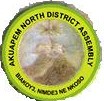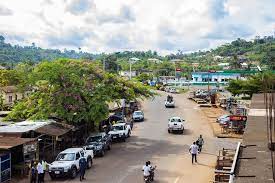Related Research Articles

Osei Tutu II is the 16th Asantehene, enstooled on 26 April 1999. By name, Otumfuo Osei Tutu II is in direct succession to the 17th-century founder of the Ashanti Empire, Otumfuo Osei Tutu I. He is also the Chancellor of the Kwame Nkrumah University of Science and Technology. Otumfuo Osei Tutu II is the Grand Patron of the Grand Lodge of Ghana and the Sword Bearer of the United Grand Lodge of England.
The Akan people are a Kwa group living primarily in present-day Ghana and in parts of Ivory Coast and Togo in West Africa. The Akan speak dialects within the Central Tano branch of the Potou–Tano subfamily of the Niger–Congo family. Subgroups of the Akan people include: the Agona, Akuapem, Akwamu, Akyem, Anyi, Ashanti, Baoulé, Bono, Chakosi, Fante, Kwahu, Sefwi, Wassa, Ahanta, and Nzema, among others. The Akan subgroups all have cultural attributes in common; most notably the tracing of matrilineal descent in the inheritance of property, and for succession to high political office.

The Golden Stool is the royal and divine throne of kings of the Ashanti people and the ultimate symbol of power in Asante. According to legend, Okomfo Anokye, High Priest and one of the two chief founders of the Asante Confederacy, caused the stool to descend from the sky and land on the lap of the first Asante king, Osei Tutu. Such seats were traditionally symbolic of a chieftain's leadership, but the Golden Stool is believed to house the spirit of the Asante nation—living, dead and yet to be born.
Akyempimhene, or vice-king, is the title bestowed upon one of the chiefs in the Ashanti Kingdom, located in Ghana, Africa. The throne is occupied by a son of any Ashanti king (Asantehene), and he takes care of the royal family. The Akyempimhene represents the king, along with the king's sub-chiefs. He is also part of the Kumasi traditional council, which oversees the city. The current Akyempimhene is Oheneba Adusei Poku, son of the late Otumfuo Nana Poku Ware. Oheneba was enstooled in 1992. He is a Harvard Law School graduate.

The Asante Empire, today commonly called the Ashanti Empire, was an Akan state that lasted from 1701 to 1901, in what is now modern-day Ghana. It expanded from the Ashanti Region to include most of Ghana as well as parts of Ivory Coast and Togo. Due to the empire's military prowess, wealth, architecture, sophisticated hierarchy and culture, the Ashanti Empire has been extensively studied and has more historic records written by European, primarily British, authors than any other indigenous culture of sub-Saharan Africa.

Akropong is a town in South Ghana and is the capital of the Akuapim North District, a district in the Eastern Region of South Ghana. This town is known for producing snails and palm oil. Akropong has a 2013 settlement population of 13,785 people.
In many parts of West Africa, there is an old chieftaincy tradition, and the Akan people have developed their own hierarchy, which exists alongside the democratic structure of the country. The Akan word for the ruler or one of his various courtiers is "Nana". In colonial times, Europeans translated it as "chief", but that is not an exact equivalent. Other sources speak of "kings", which is also not entirely correct, especially in the case of the said courtiers. The term "chief" has become common even among modern Ghanaians, though it would be more correct to use the expression "Nana" without translation wherever possible.

Otumfuo Opoku Ware II was the 15th Asantehene. He succeeded his uncle Osei Tutu Agyeman Prempeh II on 27 July 1970. He ruled for 29 years until his death in February 1999. He was succeeded by Otumfuo Nana Osei Tutu II.
In several Akan nations of Ghana, the Omanhene is the title of the supreme traditional ruler ('king') in a region or a larger town. The omanhene is the central figure and institution of the nation. Officially, he has no function in the current Ghanaian political setup, but, has enormous influence on the people that constitute it. Today 'Hene' can be found in titles of other rulers in Ghanaian nations. For example, the chief of the Dagomba in the north of Ghana is known as the 'Dagombahene'.

Sefwi Wiawso is a town in the Sefwi-Wiawso Municipal District in the Western North Region of Ghana. It doubles as the capital of Sefwi-Wiawso Municipal District and Western North Region. Wiawso serves as the traditional seat for the Omanhene of Sefwi-Wiawso traditional area. The settlement of Wiawso began on hilltop with Sefwi-Dwenase settlement occupying the lowlands. Overtime, Wiawso and Sefwi-Dwenase have conurbated with almost all the financial institutions, governmental agency-offices, lorry terminals and the main market all located in Sefwi Dwenase. Wiawso is known for producing timber, cocoa and cashew. One of Ghana's 261 Metropolitan, Municipal and District Assemblies (MMDAs), Sefwi Wiawso Municipal is a member of the 22 MMDAs in the Western North Region. Legislative Instrument (L.I) 1386, which was passed on November 23, 1988, formed the Municipality and designated Wiawso as its official capital. Based on the 2021 population and residential census, there are 151,220 people living in the Municipality, including 75,905 men and 75,315 women.
There are four orders in Ghana: Order of the Star of Ghana, Order of the Volta, Medal for Gallantry and Grand Medal.

An Akrafena is an Ashanti sword, originally meant for warfare but also forming part of Ashanti heraldry. The foremost example of an akrafena is the Mponponsuo, which belonged to Opoku Ware II. It has survived to the present day because it is still occasionally used in ceremonies, such as the Akwasidae Festival.
Nana Otuo Siriboe is a Ghanaian traditional ruler, electrical engineer and entrepreneur. He is the Omanhene of the Juaben traditional area. He has served in several capacities in chieftaincy affairs and held many Government of Ghana appointments. He is currently the Chairman of the eighth Council of State of the Fourth Republic.
The chieftaincy institution in Ghana is a system that structures and regulates the activity of local chieftains in the Ghanaian society and state.
Okogyeabour Nkuah Okomdom II was a traditional ruler and Paramount chief of the Sefwi Wiawso Traditional Area in the Western Region of Ghana from 1997 to 2011.
The political organization of the historical Ashanti Empire was characterized by stools which denoted "offices" that were associated with a particular authority. The Golden Stool was the most powerful of all, because it was the office of the King of the Ashanti Empire. Scholars such as Jan Vansina have described the governance of the Ashanti Empire as a federation where state affairs were regulated by a council of elders headed by the king, who was simply primus inter pares.

Her Royal Highness Oheneba Lesley Akyaa Opoku Ware is a Ghanaian physician and diplomat. She is the ambassador of Ghana to the Russian Federation. Opoku Ware is also trained as a family physician. In 2017, she was appointed by Ghana's president as the Ambassador to the Russian Federation. She is also the ambassador to several other countries including Armenia.

Oheneba is a regal rank given to both female or male child of a king or chief. It is the equivalent of prince or princess.
The Asantehemaa is the queen mother according to West African custom, who rules the Asante people alongside the Asantehene. African queen mothers generally play an important role in local government; they exercise both political and social power. Their power and influence have declined considerably since pre-colonial times, but still persist in the 21st century.
References
- ↑ Bendezú Untiveros, Raúl Eduardo (2021-05-15). "Los caminos semióticos de la Nueva Teoría Estratégica". Razón y Palabra. 25 (110). doi: 10.26807/rp.v25i110.1768 . ISSN 1605-4806.
- 1 2 3 4 5 "Kingdom of Sefwi Obeng-Mim – The Arlington Herald" . Retrieved 2023-12-29.
- ↑ "Royal patron – HSA" . Retrieved 2023-12-29.
- ↑ Redacción (2019-11-03). "Asamblea Extraordinaria De La H.N.M.E. En Granada". El Monárquico (in Spanish). Retrieved 2023-12-29.
- 1 2 3 4 5 6 7 8 9 LLC, Moonlight Computing. "Royal House of Sefwi Obeng-Mim". royalhousemim.org. Retrieved 2023-12-29.
- ↑ zrzutka.pl (2021-10-17). "Plantacja kakao w Ghanie - kawałek Polski w Afryce". zrzutka.pl. Retrieved 2023-12-29.
- ↑ "Ghana School Projects". tuscanyglobal.com. Retrieved 2023-12-29.
- ↑ "Money Matters", Dear Doctor, 1517 Media, pp. 131–140, 2020-08-11, doi:10.2307/j.ctvzcz2sn.15 , retrieved 2023-12-29
- 1 2 "Augustan Society | Recognized Fontes Honorum". www.augustansociety.org. Retrieved 2023-12-29.